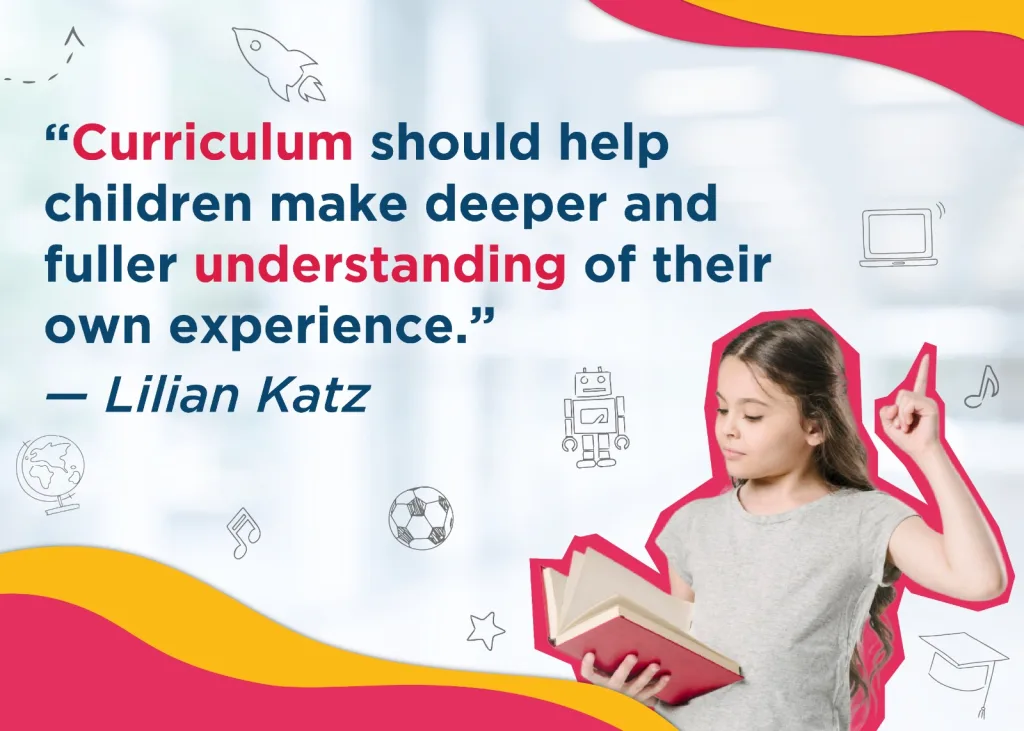No products in the cart.

Importance of school curriculum development:
Curriculum development is an aspect of the educational process that forms the backbone of any educational institution, shaping the academic structure of schools and guiding their teaching-learning processes. In the context of the National Education Policy (NEP) 2020, curriculum development emphasizes the importance of conceptual understanding, holistic learning, and integration of technology. Curriculum development is not a static process but a dynamic process that changes along with developments in the education industry. Keeping this in mind, principals and education experts need to stay updated with curriculum updates and effectively implement them to establish their school as an NEP ready school.
The school curriculum serves as a pathway and a roadmap that outlines the knowledge, skills, and values that a school should instil in its students during their academic journey. Adopting a high-quality curriculum in your school allows teachers to focus on implementing quality teaching methods and adopt curriculum changes to the teaching process effectively..
A well developed curriculum provides a structured framework for teachers to design instructional activities and assessments that align with the school’s desired academic outcomes. A quality curriculum ensures that students receive proper education, facilitating their holistic development and preparing them for the future.

What makes a quality curriculum?
A good quality curriculum is one that is updated and adapts to the developments in the education industry:
Adapts to developments in education:
A successful curriculum is not changed once but is updated regularly to keep up with new instructional processes in education. A curriculum tailored to recent developments in education helps influence teaching strategies and introduce new learning activities in schools. A good curriculum is a critical component in assisting teachers in keeping up with the rapid pace of education trends, and assists schools in imparting 21st century learning skills that students will require for their future.
Has Clear Learning Outcomes:
A good curriculum clearly defines the expected teaching-learning outcomes for schools for each grade, level or subject, providing teachers and students with a clear understanding of the subject content to be covered. It should also account for the diverse learning needs of students, allowing teachers to use different instructional methods to cater to various learning styles, abilities, and interests of students.
Relevance and Alignment:
A curriculum should be relevant to the current teaching syllabus in schools and should relate to the educational needs of teachers and students. Aligning a curriculum to real-world concepts and the NEP 2020 objectives is imperative for the holistic development of pupils in schools. It is through a curriculum based on current educational relevance that students can develop skills like critical thinking and problem solving as a part of their academic journey.
Contains Research-based Teaching Techniques:
Effective curriculum includes teaching approaches based on academic research and a foundation of effective instruction. Though educational research is not exhaustive, it helps provide direction to teachers in applying teaching methods in a classroom. Further study and analysis of other disciplines' processes, methods, and strategies give schools access to valid data to improve teacher instruction and appeal to students’ learning styles. A successful curriculum incorporates these research-based strategies into everyday aspects of the educational process.
Map Student’s Progress:A school curriculum that effectively maps students’ progress defines the different milestones that a student needs to achieve during the academic year. As students progress through the course, schools need to implement a well-defined curriculum that highlights the objectives and goals required to get optimal academic results.. This clarifies the school’s expectations that the students need to meet and helps boost their academic progress.

Benefits of a good curriculum:
A curriculum, if implemented well in a school, can have numerous benefits for teachers, students, and the school as a whole.
Makes teaching and learning consistent:
A curriculum provides consistent coverage of school curriculum implementation methods as per the NEP 2020, that ensures equitable instruction between classrooms of different schools. With horizontal alignment, schools can give students equal access to high-quality instruction regardless of their assigned class. Having a school follow a good curriculum facilitates the overall growth and development of its pupils.
Alignment with educational standards:
Every educational institution has certain standards that need to be followed. A school’s affiliation to a university or a government education department may define the standard or level of education that they are required to impart. Good curriculum helps define and set teaching standards that help teachers keep the course goals in sight. With the focus and outcomes of the course clear to everyone, teachers and students can work together effectively and achieve the desired learning outcomes.
Growth tracking with formative assessments:
A well-designed curriculum includes appropriate assessment methods and tools to gauge student progress and understanding. It provides opportunities for both formative and summative assessments, allowing teachers to track student growth and provide timely feedback. Effective assessment practices embedded in the curriculum help identify areas of improvement and make instructional changes in schools.
Helps teachers plan teaching strategies:
Curriculum plays a role in connecting teachers from across grade levels and subject areas to effectively adopt quality teaching methods and consider the big picture of the teaching-learning process in the classroom. A quality curriculum helps teachers work together to plan a progression of topics and teaching strategies that build conceptual understanding when taught in the classroom, reinforcing knowledge recollection over a period of time and facilitating the holistic development of students.
Encourages collaboration:
The key to implementing a school curriculum effectively is clear communication between school administrators and teachers. When the primary stakeholders have frequent discussions on the optimal teaching methods required for a school, curricular adjustments can help increase students’ chances of meeting the school’s academic benchmarks. Increased collaboration among teachers and principals/school administrators helps decide the best course of action to be taken for the upliftment of the school’s academic processes.

Role of teachers in implementing a curriculum effectively:
Teachers are the implementers of the curriculum, and are pivotal to the running of the course. Teachers are involved with curriculum evaluation and its proper implementation in the school.
Planning: Teachers play an important role in planning engaging lesson plans based on the curriculum. They analyze given curriculum documents, learning objectives, and standards to effectively design lessons and teaching approaches that align with the curriculum goals. Teachers determine the sequence of content, select appropriate instructional strategies, and create lesson plans that help form an interactive and engaging classroom.
Instruction: Teachers deliver knowledge and information using a variety of teaching methods and strategies, engaging students with active learning in the classroom. Teachers adopt instructional techniques to better implement schools’ curriculum designs and teach the curriculum content in classrooms effectively.
Integration of Technology: Teachers play a pivotal role in integrating technology into their curriculum implementation methods by leveraging educational technology tools, online resources, and multimedia to enhance teaching methods and promote digital literacy in the classroom in alignment with NEP 2020. Teachers help students develop 21st century skills and digital familiarity, using technology to effectively implement curriculum guidelines.
Summary on the importance and benefits of school curriculum development:
A well-developed curriculum provides several benefits to schools and teachers by laying out the course objectives which let teachers focus on designing specific teaching approaches and assessments to effectively improve classroom teaching. Quality curricula helps schools meet the various education standards, ensuring equity in instruction in classrooms, and facilitating the overall progress of the school.
Importance of school curriculum development:
Curriculum development is an aspect of the educational process that forms the backbone of any educational institution, shaping the academic structure of schools and guiding their teaching-learning processes. In the context of the National Education Policy (NEP) 2020, curriculum development emphasizes the importance of conceptual understanding, holistic learning, and integration of technology. Curriculum development is not a static process but a dynamic process that changes along with developments in the education industry. Keeping this in mind, principals and education experts need to stay updated with curriculum updates and effectively implement them to establish their school as an NEP ready school.
The school curriculum serves as a pathway and a roadmap that outlines the knowledge, skills, and values that a school should instil in its students during their academic journey. Adopting a high-quality curriculum in your school allows teachers to focus on implementing quality teaching methods and adopt curriculum changes to the teaching process effectively..
A well developed curriculum provides a structured framework for teachers to design instructional activities and assessments that align with the school’s desired academic outcomes. A quality curriculum ensures that students receive proper education, facilitating their holistic development and preparing them for the future.

What makes a quality curriculum?
A good quality curriculum is one that is updated and adapts to the developments in the education industry:
Adapts to developments in education:
A successful curriculum is not changed once but is updated regularly to keep up with new instructional processes in education. A curriculum tailored to recent developments in education helps influence teaching strategies and introduce new learning activities in schools. A good curriculum is a critical component in assisting teachers in keeping up with the rapid pace of education trends, and assists schools in imparting 21st century learning skills that students will require for their future.
Has Clear Learning Outcomes:
A good curriculum clearly defines the expected teaching-learning outcomes for schools for each grade, level or subject, providing teachers and students with a clear understanding of the subject content to be covered. It should also account for the diverse learning needs of students, allowing teachers to use different instructional methods to cater to various learning styles, abilities, and interests of students.
Relevance and Alignment:
A curriculum should be relevant to the current teaching syllabus in schools and should relate to the educational needs of teachers and students. Aligning a curriculum to real-world concepts and the NEP 2020 objectives is imperative for the holistic development of pupils in schools. It is through a curriculum based on current educational relevance that students can develop skills like critical thinking and problem solving as a part of their academic journey.
Contains Research-based Teaching Techniques:
Effective curriculum includes teaching approaches based on academic research and a foundation of effective instruction. Though educational research is not exhaustive, it helps provide direction to teachers in applying teaching methods in a classroom. Further study and analysis of other disciplines' processes, methods, and strategies give schools access to valid data to improve teacher instruction and appeal to students’ learning styles. A successful curriculum incorporates these research-based strategies into everyday aspects of the educational process.
Map Student’s Progress:A school curriculum that effectively maps students’ progress defines the different milestones that a student needs to achieve during the academic year. As students progress through the course, schools need to implement a well-defined curriculum that highlights the objectives and goals required to get optimal academic results.. This clarifies the school’s expectations that the students need to meet and helps boost their academic progress.

Benefits of a good curriculum:
A curriculum, if implemented well in a school, can have numerous benefits for teachers, students, and the school as a whole.
Makes teaching and learning consistent:
A curriculum provides consistent coverage of school curriculum implementation methods as per the NEP 2020, that ensures equitable instruction between classrooms of different schools. With horizontal alignment, schools can give students equal access to high-quality instruction regardless of their assigned class. Having a school follow a good curriculum facilitates the overall growth and development of its pupils.
Alignment with educational standards:
Every educational institution has certain standards that need to be followed. A school’s affiliation to a university or a government education department may define the standard or level of education that they are required to impart. Good curriculum helps define and set teaching standards that help teachers keep the course goals in sight. With the focus and outcomes of the course clear to everyone, teachers and students can work together effectively and achieve the desired learning outcomes.
Growth tracking with formative assessments:
A well-designed curriculum includes appropriate assessment methods and tools to gauge student progress and understanding. It provides opportunities for both formative and summative assessments, allowing teachers to track student growth and provide timely feedback. Effective assessment practices embedded in the curriculum help identify areas of improvement and make instructional changes in schools.
Helps teachers plan teaching strategies:
Curriculum plays a role in connecting teachers from across grade levels and subject areas to effectively adopt quality teaching methods and consider the big picture of the teaching-learning process in the classroom. A quality curriculum helps teachers work together to plan a progression of topics and teaching strategies that build conceptual understanding when taught in the classroom, reinforcing knowledge recollection over a period of time and facilitating the holistic development of students.
Encourages collaboration:
The key to implementing a school curriculum effectively is clear communication between school administrators and teachers. When the primary stakeholders have frequent discussions on the optimal teaching methods required for a school, curricular adjustments can help increase students’ chances of meeting the school’s academic benchmarks. Increased collaboration among teachers and principals/school administrators helps decide the best course of action to be taken for the upliftment of the school’s academic processes.

Role of teachers in implementing a curriculum effectively:
Teachers are the implementers of the curriculum, and are pivotal to the running of the course. Teachers are involved with curriculum evaluation and its proper implementation in the school.
Planning: Teachers play an important role in planning engaging lesson plans based on the curriculum. They analyze given curriculum documents, learning objectives, and standards to effectively design lessons and teaching approaches that align with the curriculum goals. Teachers determine the sequence of content, select appropriate instructional strategies, and create lesson plans that help form an interactive and engaging classroom.
Instruction: Teachers deliver knowledge and information using a variety of teaching methods and strategies, engaging students with active learning in the classroom. Teachers adopt instructional techniques to better implement schools’ curriculum designs and teach the curriculum content in classrooms effectively.
Integration of Technology: Teachers play a pivotal role in integrating technology into their curriculum implementation methods by leveraging educational technology tools, online resources, and multimedia to enhance teaching methods and promote digital literacy in the classroom in alignment with NEP 2020. Teachers help students develop 21st century skills and digital familiarity, using technology to effectively implement curriculum guidelines.
Summary on the importance and benefits of school curriculum development:
A well-developed curriculum provides several benefits to schools and teachers by laying out the course objectives which let teachers focus on designing specific teaching approaches and assessments to effectively improve classroom teaching. Quality curricula helps schools meet the various education standards, ensuring equity in instruction in classrooms, and facilitating the overall progress of the school.
